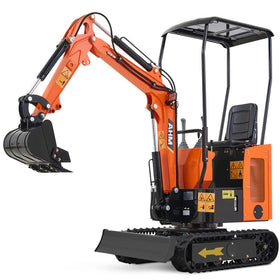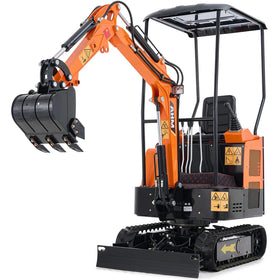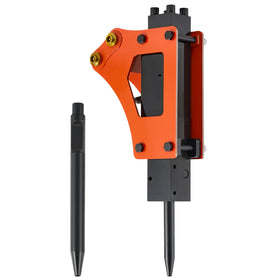Skid loaders come in many sizes, weighing anywhere from 2,900 pounds for the smallest models to over 12,000 pounds for the largest machines.
Knowing exactly how much these versatile machines weigh can help you have safer transportation, proper job site selection, and efficient operation. This guide breaks down skid loader weights by size and brand, helping you choose the right machine for your specific needs.
Skid Loader Weight Range By Size
Skid loaders typically fall into three main weight categories:
- Small Skid Loaders weigh between 2,900 and 6,000 pounds
- Medium Skid Loaders weigh between 6,000 and 8,000 pounds
- Large Skid Loaders weigh between 8,000 and 12,000 pounds
- Mini Skid Loaders weigh between 1,500 and 2,900 pounds
Most common skid loaders used on construction sites weigh around 7,500 pounds, the medium-sized category.
Why Skid Loader Weight Matters For Your Job
The weight of a skid loader can affect many aspects of your work:
1. Transportation Requirements
Matching your skid loader's weight to the right transportation equipment is critical. Smaller machines under 6,000 pounds can often be moved with a standard equipment trailer and 3/4-ton truck. Larger machines over 8,000 pounds require dedicated heavy equipment trailers and one-ton trucks or larger.
2. Ground Impact And Surface Damage
Heavier skid loaders put more pressure on the ground, which can cause:
- Damage to concrete driveways and surfaces
- Deep ruts in soil, especially after rain
- Significant lawn damage in residential settings
3. Stability And Lifting Capacity
Weight directly relates to stability and lifting ability. Heavier machines generally offer:
- Higher rated operating capacity
- Better stability when lifting heavy materials
- More pushing power for tasks like grading
Equipment World notes that "the weight distribution of a skid loader is critical to its performance, especially when working with heavy attachments or on uneven terrain."
Type #1: Small Skid Loader Weights And Uses

Small skid loaders weigh between 2,900 and 6,000 pounds and offer excellent maneuverability in tight spaces. Here are the weights of popular small skid loader models:
|
Brand/Model |
Operating Weight |
Rated Capacity |
Horsepower |
|
Bobcat S70 |
2,892 lbs |
760 lbs |
24 hp |
|
Bobcat S450 |
5,370 lbs |
1,370 lbs |
49 hp |
|
CASE SR160B |
5,645 lbs |
1,600 lbs |
60 hp |
|
GEHL R105 |
4,200 lbs |
1,049 lbs |
34 hp |
These machines typically have engines ranging from 23 to 65 horsepower and can lift between 700 to 1,750 pounds safely.
Best Jobs For Small Skid Loaders
Small skid loaders work best for:
- Jobs in tight spaces like indoor demolition
- Residential landscaping where access is limited
- Projects requiring access through standard doorways
- Light-duty material handling
A key advantage is their ability to work in confined spaces without causing excessive damage to finished surfaces. Many can fit through a standard 6-foot gate or 36-inch doorway.
Type #2: Medium Skid Loader Weights And Uses

Medium skid loaders weighing between 6,000 and 8,000 pounds are the most versatile and commonly used size. Here are weights for popular medium-sized models:
|
Brand/Model |
Operating Weight |
Rated Capacity |
Horsepower |
|
Bobcat S590 |
6,765 lbs |
2,101 lbs |
68 hp |
|
CASE SR210B |
6,970 lbs |
2,100 lbs |
74 hp |
|
CAT 242D3 |
7,138 lbs |
2,200 lbs |
74 hp |
|
John Deere 320G |
7,150 lbs |
2,190 lbs |
69 hp |
|
Kubota SSV65 |
7,319 lbs |
1,950 lbs |
64 hp |
These machines typically offer 65-75 horsepower engines and can safely lift between 1,750 to 2,200 pounds.
Best Jobs For Medium Skid Loaders
Medium skid loaders excel at:
- General construction projects
- Moderate excavation and grading
- Material handling on medium-sized job sites
- Snow removal for commercial properties
According to Construction Equipment Magazine, medium-sized skid loaders handle approximately 70% of typical construction tasks more efficiently than other sizes, making them the most popular choice for contractors.
Type #3: Large Skid Loader Weights And Uses

Large skid loaders weighing between 8,000 and 12,000 pounds provide maximum power and lifting capacity for demanding jobs. Here are weights for leading large skid loader models:
|
Brand/Model |
Operating Weight |
Rated Capacity |
Horsepower |
|
Bobcat S850 |
10,237 lbs |
3,950 lbs |
100 hp |
|
GEHL V420 |
11,665 lbs |
4,200 lbs |
120 hp |
|
John Deere 334 P-Tier |
10,264 lbs |
4,000 lbs |
115 hp |
|
CAT 272D3 |
9,133 lbs |
3,450 lbs |
98 hp |
|
Manitou 4200V |
11,665 lbs |
4,200 lbs |
120 hp |
These powerful machines typically feature 90-120 horsepower engines and can safely lift between 2,200 to 4,200 pounds.
Best Jobs For Large Skid Loaders
Large skid loaders are best suited for:
- Heavy demolition work
- Large-scale excavation projects
- Lifting heavy materials like concrete barriers
- Commercial construction sites with adequate space
The Equipment World Magazine emphasizes that "matching the skid loader size to the job requirements ensures both safety and productivity on the worksite."
Type #4: Mini Skid Loader Weights And Uses

Mini skid loaders are the smallest class, weighing between 1,500 and 2,900 pounds. These compact machines offer incredible maneuverability in extremely tight spaces.
|
Brand/Model |
Operating Weight |
Rated Capacity |
Horsepower |
|
AHM SS-380 |
1,733 lbs |
826 lbs |
23 hp |
|
Ditch Witch SK600 |
2,510 lbs |
600 lbs |
24.8 hp |
|
Toro Dingo TX 427 |
1,960 lbs |
535 lbs |
27 hp |
|
Vermeer S925TX |
2,500 lbs |
925 lbs |
25 hp |
The AHM SS-380 is particularly notable for its compact design at just 45.3 inches wide while still offering impressive performance with a 6.2-foot lift height and 826-pound lift capacity.
Best Jobs For Mini Skid Loaders
Mini skid loaders excel at:
- Ultra-tight access areas like inside buildings
- Small residential landscaping projects
- Garden and farm work with space constraints
- Indoor warehouse operations
- Jobs where minimal surface impact is critical
These machines can often fit through standard 36-inch doorways and gates as small as 4 feet wide. Thus they are perfect for jobs where even small skid loaders won't fit.
How Attachments Affect Skid Loader Weight
Adding attachments increases the operating weight of your skid loader. Here's how much common attachments typically add:
|
Attachment |
Weight Range |
Effect on Operation |
|
Standard Bucket |
250-400 lbs |
Minimal impact |
|
Pallet Forks |
185-300 lbs |
Forward weight shift |
|
Brush Cutter |
900-2,000 lbs |
Significant weight; affects stability |
|
Grapple Bucket |
600-900 lbs |
Forward weight shift |
|
Trencher |
600-1,500 lbs |
Major forward weight shift |
|
Snow Blower |
600-1,000 lbs |
Forward weight shift |
OSHA's construction equipment guidelines state that "operators must account for attachment weights when calculating load limits and machine stability." Heavy attachments significantly change a machine's center of gravity and can reduce its safe lifting capacity.
Transportation Weight Limits For Skid Loaders

Safely transporting skid loaders requires matching the machine weight to appropriate equipment:
|
Skid Loader Size |
Trailer Capacity Needed |
Truck Recommendation |
License Requirements |
|
Mini (<3,000 lbs) |
3,500 lbs minimum |
1/2-ton pickup |
Standard license |
|
Small (3,000-6,000 lbs) |
7,500 lbs minimum |
3/4-ton truck |
Standard license |
|
Medium (6,000-8,000 lbs) |
10,000 lbs minimum |
3/4-ton or 1-ton |
May require CDL in some states |
|
Large (>8,000 lbs) |
14,000+ lbs minimum |
1-ton dually or larger |
Often requires CDL |
Surface Damage From Different Weight Classes
The weight of your skid loader directly affects how it interacts with different surfaces:
Concrete And Asphalt Surfaces
- Small Loaders: Safe on properly cured 4" concrete
- Medium Loaders: Require minimum 4-5" concrete
- Large Loaders: Need 6"+ concrete to prevent cracking
- Mini Loaders: Can work on standard residential concrete with minimal risk
Landscaped Areas And Lawns
- Small Loaders: Cause minimal damage in dry conditions
- Medium Loaders: Create noticeable ruts, especially when turning
- Large Loaders: Can cause significant soil displacement and turf damage
- Mini Loaders: Leave minimal footprint even in somewhat wet conditions
Tracked Vs Wheeled Skid Loader Weights
Tracked versions of skid loaders typically weigh 15-20% more than their wheeled counterparts but distribute weight better across the ground:
- A wheeled Bobcat S590 weighs 6,765 pounds
- The tracked version (T590) weighs 7,829 pounds
Despite being heavier, tracked machines exert less ground pressure:
- Wheeled medium skid loaders: 35-45 PSI ground pressure
- Tracked medium skid loaders: 5-8 PSI ground pressure
This lower ground pressure makes tracked models better for soft surfaces despite their higher overall weight.
Choosing The Right Weight Skid Loader
When selecting a skid loader based on weight, consider these factors:
- Lifting needs - Match the machine's rated capacity to your typical loads
- Transportation equipment - Ensure you can safely move the machine
- Job site conditions - Consider ground surfaces and potential damage
- Access requirements - Heavier machines are typically larger and wider
- Attachment compatibility - Heavier attachments require larger base machines
For most general contractors, a medium-weight machine around 7,000 pounds provides the best balance of power, transportability, and versatility.
Common Questions About Skid Loader Weight
Do skid loaders weigh more than compact track loaders?
No, compact track loaders (CTLs) typically weigh 15-20% more than similar-sized skid steer loaders due to their track systems and undercarriage.
What is the lightest skid loader available?
The Bobcat S70 is currently the lightest production standard skid loader at 2,892 pounds. For even lighter options, mini skid loaders like the AHM SS-380 weigh as little as 1,733 pounds.
What is the heaviest skid loader on the market?
The GEHL V420 and Manitou 4200V are among the heaviest at 11,665 pounds.
Does weight affect fuel consumption?
Yes, heavier machines typically consume 30-40% more fuel than lighter models performing similar tasks. Mini skid loaders like the AHM SS-380 are specifically designed for fuel efficiency, with their 20L tank providing up to 7 hours of operation.
The Right Skid Loader Weight For Your Job
Choosing the right skid loader weight is all about matching the machine to your specific job requirements. After analyzing hundreds of job sites and machines, the pattern is clear:
- Mini skid loaders under 3,000 pounds are perfect for indoor work, tight access, and jobs where minimal surface impact is critical
- Small skid loaders between 3,000-6,000 pounds handle residential work and lighter commercial jobs efficiently
- Medium skid loaders in the 6,000-8,000 pound range deliver the versatility most contractors need for everyday construction tasks
- Large skid loaders over 8,000 pounds bring the muscle for heavy commercial and industrial applications
Conclusion

Now that you know how skid steer weight impacts everything from transport to job site performance, the next step is clear: take a close look at your own projects and priorities. What kind of terrain do you work on? How often do you need to move your machine? What loads do you regularly lift?
If you’re unsure where to start, consider reaching out to local dealers or equipment experts who can help you test different models and find the best fit. And if you’re already using a skid steer, take a moment to evaluate whether your current machine is making your work easier or harder. Sometimes a small change in size or weight can make a big difference on the job.
Further Reading:
Skid Steers Vs Mini-Excavators? Which Is Better For Digging







